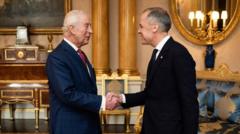Mark Carney's historic invitation to King Charles III as he opens the 45th Canadian parliament represents a notable shift in Canada's connection to the British monarchy, serving as an affirmation of the country's sovereignty during a time of political strain with former President Trump.
King Charles III's Invitation to Canada: A Political Statement in the Trump Era

King Charles III's Invitation to Canada: A Political Statement in the Trump Era
In a strategic move by Prime Minister Mark Carney, King Charles III has been invited to Canada, signaling a new era in the country's relationship with the monarchy amid tensions with the U.S.
King Charles III's upcoming visit to Canada, set to be the first by a British monarch since 1977, reflects both historical significance and modern political intent as Prime Minister Mark Carney uses the occasion to assert Canadian independence in the face of U.S. pressures.
In Prime Minister Mark Carney’s inaugural move following his election victory, he extended an invitation to King Charles III to come to Canada, marking a political shift as the country strengthens ties with the monarchy. This invitation stands in stark contrast to events from a decade ago when former Prime Minister Stephen Harper's display of loyalty to the Crown sparked controversy.
During Harper's time, there was public backlash over his emphasis on monarchy, especially when he removed artwork by a Quebec painter to showcase a portrait of the Queen, which many considered outdated given Canada's historical pursuit of autonomy from British colonialism.
However, under Prime Minister Justin Trudeau, the dynamic shifted. The monarch's portrait was taken down, while Canadian art was celebrated, reflecting a progressive detachment from historical ties. Now, as Canada eagerly steps into a new chapter with Carney at the helm, the invitation to King Charles signifies a return to embracing royal connections, especially amid political estrangement from Trump’s administration.
Royal historians say that the invitation to deliver the Speech from the Throne emphasizes the unique identity of Canada, distinguishing itself from its American neighbor – a country that severed royal ties over two centuries ago. With the ongoing economic and political tensions from the U.S., Carney's move underscores a commitment to sovereignty as he counters Trump’s assertions of Canada as America’s "51st state."
Historically, loyalty to the Crown was a critical asset for Canadian leaders keen on maintaining a distinct identity from the U.S., but this has fluctuated through the decades, particularly with the rise of Quebec nationalism and movements for reconciliation with indigenous peoples. As the monarchy faces scrutiny over its colonial past, support for it among the population appears divided.
The upcoming royal visit comes at a pivotal moment when many Canadians remain indifferent or critical of the monarchy, yet it also symbolizes a chance for Carney to rejuvenate relations with Trump and establish a closer rapport with European allies. Although the monarchy may not universally appeal to Canadians today, the visit is anticipated to resonate with those enamored by tradition.
With the King's first visit pending, the palace has promised a throne speech that aims to strengthen ties between the monarch and the Canadian populace, conveying a message of collaboration during a politically charged period. In this brief visit, which kicks off with ceremonial grandeur and concludes shortly after, the significance of the moment will seek to resonate beyond the pageantry, potentially shaping a new narrative of Canadian independence and identity.
In Prime Minister Mark Carney’s inaugural move following his election victory, he extended an invitation to King Charles III to come to Canada, marking a political shift as the country strengthens ties with the monarchy. This invitation stands in stark contrast to events from a decade ago when former Prime Minister Stephen Harper's display of loyalty to the Crown sparked controversy.
During Harper's time, there was public backlash over his emphasis on monarchy, especially when he removed artwork by a Quebec painter to showcase a portrait of the Queen, which many considered outdated given Canada's historical pursuit of autonomy from British colonialism.
However, under Prime Minister Justin Trudeau, the dynamic shifted. The monarch's portrait was taken down, while Canadian art was celebrated, reflecting a progressive detachment from historical ties. Now, as Canada eagerly steps into a new chapter with Carney at the helm, the invitation to King Charles signifies a return to embracing royal connections, especially amid political estrangement from Trump’s administration.
Royal historians say that the invitation to deliver the Speech from the Throne emphasizes the unique identity of Canada, distinguishing itself from its American neighbor – a country that severed royal ties over two centuries ago. With the ongoing economic and political tensions from the U.S., Carney's move underscores a commitment to sovereignty as he counters Trump’s assertions of Canada as America’s "51st state."
Historically, loyalty to the Crown was a critical asset for Canadian leaders keen on maintaining a distinct identity from the U.S., but this has fluctuated through the decades, particularly with the rise of Quebec nationalism and movements for reconciliation with indigenous peoples. As the monarchy faces scrutiny over its colonial past, support for it among the population appears divided.
The upcoming royal visit comes at a pivotal moment when many Canadians remain indifferent or critical of the monarchy, yet it also symbolizes a chance for Carney to rejuvenate relations with Trump and establish a closer rapport with European allies. Although the monarchy may not universally appeal to Canadians today, the visit is anticipated to resonate with those enamored by tradition.
With the King's first visit pending, the palace has promised a throne speech that aims to strengthen ties between the monarch and the Canadian populace, conveying a message of collaboration during a politically charged period. In this brief visit, which kicks off with ceremonial grandeur and concludes shortly after, the significance of the moment will seek to resonate beyond the pageantry, potentially shaping a new narrative of Canadian independence and identity.




















